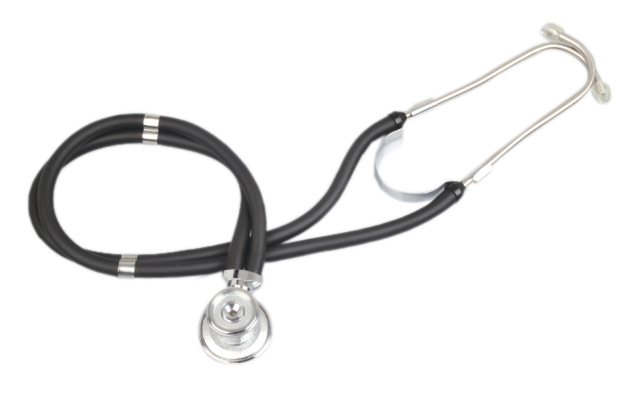
Sprague-Rappaport Stethoscope
A Sprague-Rappaport stethoscope is a type of medical device that is used to listen to heart, lung, and other body sounds
| Ref. No.: | Description: |
|---|---|
| NMDE220501 | Sliver head, black tubing |
| NMDE220502 | Sliver head, grey tubing |
| NMDE220503 | Sliver head, navy blue tubing |
A Sprague-Rappaport stethoscope is a type of medical device that is used to listen to heart, lung, and other body sounds. It consists of two earpieces connected by tubing to a chest piece. The chest piece has a diaphragm and two bells of different sizes. The smaller bell is used to listen to high-pitched sounds, such as the heartbeat, while the larger bell is used to listen to low-pitched sounds, such as the lungs. The earpieces are placed in the ears and the tubing is wrapped around the head and neck.
There are many advantages of Sprague-Rappaport stethoscopes. They are known for their durability, comfort, and versatility. Many doctors and nurses prefer them because they can be used for both adults and children. Sprague-Rappaport stethoscopes are also very affordable, making them a great option for those on a budget. Additionally, they are easy to clean and maintain, which is important for keeping them in good condition.
There are a few disadvantages associated with Sprague-Rappaport stethoscopes. One of the biggest disadvantages is that they can be difficult to use for people who are not used to them. It can take some time to get used to the different parts of the stethoscope and how they work together. Another disadvantage is that they are not as widely available as other types of stethoscopes, so it may be difficult to find one that meets your specific needs.
When it comes to choosing a Sprague Rappaport stethoscope, there are a few things you need to keep in mind. First, consider what type of practitioner you are. If you are a cardiologist, for example, you will need a different type of stethoscope than someone who works in primary care. Second, think about what features are most important to you. Do you need a stethoscope that is specifically designed for cardiology? Or one that is more general purpose? Third, consider your budget. Sprague Rappaport stethoscopes range in price from around $30 to $200.
Now that you know what to look for, let's take a look at some of the best Sprague Rappaport stethoscopes on the market:
1. The 3M Littmann Cardiology IV Diagnostic Stethoscope is one of the best options for cardiologists. It features excellent acoustic sensitivity and comes with multiple ear tips for a comfortable fit. It also has a non-chill rim and diaphragm for patient comfort.
2. The ADC Adscope 615 Platinum Professional Cardiology Stethoscope is another great option for cardiologists. It has excellent acoustics and comes with multiple ear tips for a comfortable fit. It also has a non-chill rim and diaphragm for patient comfort.
3. The MDF Instruments MD One Stainless Steel Premium Cardiology Stethoscope is a good option for general practitioners. It has excellent acoustics and comes with multiple ear tips for a comfortable fit. It also has a non-chill rim and diaphragm for patient comfort.
4. The 3M Littmann Classic III Monitoring Stethoscope is a good option for nurses and other medical professionals who need a stethoscope for monitoring patients. It has excellent acoustics and comes with multiple ear tips for a comfortable fit. It also has a non-chill rim and diaphragm for patient comfort.
5. The Omron Sprague Rappaport Stethoscope is a good option for those on a budget. It has decent acoustics and comes with three different size eartips for a comfortable fit.